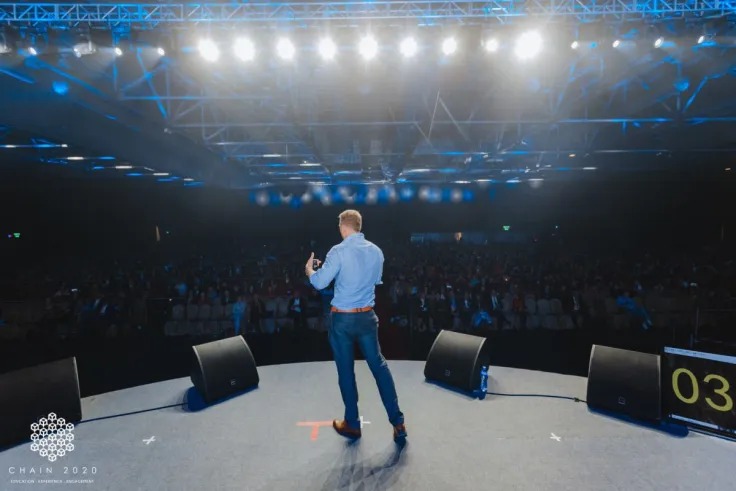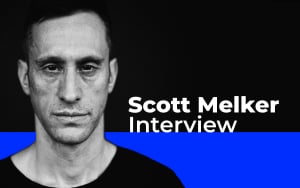
Disclaimer: The opinions expressed by our writers are their own and do not represent the views of U.Today. The financial and market information provided on U.Today is intended for informational purposes only. U.Today is not liable for any financial losses incurred while trading cryptocurrencies. Conduct your own research by contacting financial experts before making any investment decisions. We believe that all content is accurate as of the date of publication, but certain offers mentioned may no longer be available.
In this new interview dedicated to cryptocurrency trading and investment strategy, I tried to go even deeper to understand what principles are the most important if you don't want to lose money, what basis you need to learn to make your own price analysis more accurate, and what investment rules you should stick to, to finally establish a profitable crypto portfolio. Chris Jaszczynski, a cryptocurrency analyst and trader from one of the most popular YouTube channels on cryptoanalysis, MMCrypto, shared with us his knowledge about all of these important questions.
U.Today: Chris, thank you for joining the interview! I think your channel MMCrypto is one of the top five crypto channels, right? Can you please tell us what brought you to the world of blockchain technology?
Chris MMCrypto: Yeah, first of all, top five in daily average views. I think the views is what it comes down to. We are very happy that everyone is watching our videos and watching U.Today. What brought me to crypto, I think it was around 2014 or 2015 when I heard about it the first time, but I only had like network marketers approaching me with these cloud mining schemes and so it was kind of annoying me at first to hear about Bitcoin. But I studied economics back in the days and I learned about the monetary system, about the financial system, about the central banking system, and the more I learned about it, the more I understood, “Well, maybe you should look into that Bitcoin topic again.” And then I saw some content like, “Alright, you can just buy and hold Bitcoin and this is like money. It just has all the properties of money and it's even better because you cannot artificially inflate it until infinity.”
By the way, I also completed my studies in economics, and I took that knowledge, I combine it with Bitcoin and just thought that it might really change the world. This is improving so many things which go wrong in the central banking system, in the financial system and that's why I started to dig deep in. I bought Bitcoin, of course. I wanted to have my personal gain with it. I wanted to increase my purchasing power with it. But I did with a team. We had, like, a few people in the team. Now we still have six or seven people in the team, whereas I'm the face, I'm talking on YouTube and so on and go to conferences standing on stage. We invested in Bitcoin and in altcoins, and even in ICOs back in those days. It went so well that we just decided to share our knowledge, share the framework with the public. And the best way is YouTube of course. That's the short story.

Image by MMCrypto
U.Today: And why did you decide to become a crypto trader?
Chris MMCrypto: I think it started somehow towards the end of the bull market in 2017 when we decided, “well, you cannot only buy and hold”, which is the biggest part of our portfolio. Then we also invested in ICOs. But on top of that, we thought, “well, let's outperform the market.” So, we also started trading. I was actually also a little bit trading even before crypto. I started to develop my knowledge in that space and started with a training account. That started to go well. But, as I said, this should apply to really everyone in that space. Buying and holding should be the vast majority of the portfolio because I think if you are a Bitcoin or crypto enthusiast, we can all agree on the fact that in the very long run there's only one direction and that's up, right?
So if you truly believe in that buying and holding, it's the only way where you can for 100% certainty, secure yourself in that train. And if you are trading with everything you have, there might be the possibility that you lose it all. This is for sure not what we want and that's why we are trading with a maximum of 20% of our portfolio.
U.Today: Do you have experience in trading stocks? Did it help you?
Chris MMCrypto: Yes. But it was on a much smaller scale. I was a student back in those days and, of course, I was not yet a full entrepreneur and my funds were very limited. So, I did it on an extremely small scale. But this applies to everyone. I mean you have to start small, right? And you start small and with the discipline and with the framework of trading, investing, and holding you can eventually step up your game from small numbers to big numbers.
U.Today: What cryptocurrencies do you invest in?
Chris MMCrypto: If you take cryptocurrency really as a currency, you could call it speculation because investing, itself, usually means that you invest into dividend stocks and you get a cash flow out, you invest into property and real estate, right? You take a loan or invest into real estate and then the tenant just pays off your loan. This is all combined with the cash flow and an appreciation. For currencies actually, it is very hard to call it investing. However, many people say Bitcoin is a store of value just like gold, and you can invest in gold. Gold is not only a currency, it's an asset, actually, it's a commodity. So, it really depends on how you define cryptocurrencies. But I would say yes, I’m an investor, especially in things like Ethereum. You can actually lock up Etherium, can gain interest on that, you can give out loans in Ethereum, you can do so much stuff, you can build decentralized autonomous organizations, which gives you a cash flow. So, in cryptocurrencies, you can for sure call yourself an investor if you define it the right way.
U.Today: Do you invest in other cryptocurrencies apart from Bitcoin or Ethereum?
Chris MMCrypto: Yeah, it was during the whole bear market, the vast majority was invested in Bitcoin. I'm not only talking for myself, also for the team. So, the biggest part was in Bitcoin for sure. And ever since we realized how important decentralized finance and decentralized autonomous organizations can be for crypto, we understood that Ethereum might take the second spot.
Once we saw that the value locked up in decentralized finance went from 300 million to 1 billion in a short amount of time between, I think, like January to March or so, we thought, well this is going parabolic and it might continue and right now it is continuing to go parabolic.
So, there are many projects out there, but we decided, “all right, we will, first of all, scale into Ethereum” and now we switched part of our portfolio from Bitcoin also over into Ethereum, which is still below 20%. I can say that it's actually way below 10%, but before it was 100% Bitcoin and now it's also Ethereum. We are looking out for other de-fi projects and maybe we will also switch a little bit into Monero.
U.Today: What are your own investment principles, if you have any?
Chris MMCrypto: Yeah, sure. I always try to look at the best ones in the space. For example, George Soros. You can say everything you want about him in terms of ethics, but in terms of investment ethics, he's a very crazy guy. He's actually very successful. He said, “You should invest when there's blood in the streets.” So, whenever the sentiment is extremely horrible, this is actually the best time to invest. This shouldn't come with a surprise. But if you are yourself in a situation and you can see bad news everywhere, the price just plunges down to $6,400 and there's a lot of blood on these streets. Everyone is losing money, everyone is fearful. This is the exact time. But from a psychological way, it's very hard to stick to that principle. However, we are trying to remind ourselves of that every day.

Image by MMCrypto
Right now, Bitcoin is deep down, we still think we are in the long term uptrend, but with that quote in mind from George Soros, this holds really too fast and we are trying to remind ourselves every day of that, especially right now when we've dropped from 10,300 to 9,300, like $1,000. There's already blood in the streets. So if you want to dollar cost average dynamically, this might be a good starting point right now. Another thing is from Warren Buffett. He said, “Rule number one is don't lose money and rule number two was never forget the rule number one.” Another one in addition to that is Warren Buffett also said, “Be fearful when others are greedy and greedy when others are fearful.”
So, for example, when there's blood in the streets, you should be greedy. But on the other hand, when everyone is greedy, you should be fearful. If you are greedy when everyone is greedy, so in the end of the parabolic bull market or when you can see all of the mainstream media talking good about Bitcoin, this might be the moment where you should start getting out and this prevents you from losing money. This is actually a very good principle referring back to Warren Buffet who said that you should never lose money because by not losing money you can make sure that your compound interest of your portfolio is not getting hurt, right?
U.Today: Right. This is probably a difficult question, but how do you analyze charts? Can you give us any advice?
Chris MMCrypto: Yeah, so most of the people use technical analysis. We are using that as well, but less than 50% if you look at the time we are allocating to it. More than 50% we are allocating towards fundamental function analysis. So, Bitcoin is on the blockchain. It's a distributed ledger on the blockchain. Who sends money from where to where, right? It's basically only a deduction on balance A and surplus on balance B. And, with these small things, with the timestamps, the amounts being sent from A to B and from B to A and from B to C with this information, you can measure greed, fear, you can measure whenever people are on average buying on a profit, selling on a loss and so on.
You can pull out so many indicators, the leading indicators, lagging indicators from the Bitcoin blockchain, and these are all on-chain fundamental indicators. And for Bitcoin, the first time in the history of mankind, in the history of investing, we have a distributed, completely transparent ledger, which is giving us all the information we need to measure greed, fear, to see when it is the most profitable time that we bottom out, that we topped up in a bull market. This is amazing.
With these things you can, with a very high degree of certainty, predict bear market bottoms, bull market highs, certain retracement levels within these cycles and many, many other things. I could talk about that for an hour or so. So this is truly revolutionary. We think this is the future of trading. Also, it's not intraday trading, but you can use it for example, for swing trading, for midterm trading. And this is what we are doing on our channel and we are pushing much more content about that in the future. So, to answer your question, technical analysis but also on-chain fundamental analysis, which is, in our opinion, even more important.
U.Today: Is it hard to learn?
Chris MMCrypto: No, it's actually easy. Everyone knows technical analysis, the Fibonacci retracements, moving averages, everything you can see in the charts. To understand on-chain fundamental metrics, you need to understand how blockchain works, first of all. Well, this should be a basic principle before you ever touch Bitcoin. But you have to understand that, then you have to understand what data points are on the blockchain. For example, how many Bitcoin was sent from which address to which address, what was the transaction fee, at what time was it sent. Once you understand all of that, that takes maybe one hour, two hours to understand it properly, like the basics, of course, from a high level, then you can start looking into that. For example, we take one indicator and if something crazy happens, we make a video out of it, which is just like a 10-minute video. After watching that video you already understand the very fundamentals of that indicator.
And this alone shows you how easy it is. If after 10 minutes you already understand the basics. That's easy. And we are planning to publish maybe some other content like longer videos about every indicator. We don't have a more detailed way, but in our content from our channel, it's like 10 minutes you can understand everything you need for your studies already.
U.Today: That's great. I'll try it. So, the next question is, when do you think the next Bitcoin all-time high will be?
Chris MMCrypto: I think until the halvening we might approach a level of $14,000. I think the all-time high will reach after the halvening, which shouldn't come with any surprise. I think we can reach it in 2020 not only with the halvening height but also from looking at the technicals and the on-chain fundamental metrics. Many, many things point towards the fact that we can make a 100% gain, which it needs to get to $19,700 which also is the all-time high in 2020. One year is such a long time in crypto and we already suffered such a crazy bear market until the end of 2018. We had another six or seven months retracement from the $14,000 high to the $6,400 low. I think a lot of blood was already on the streets. I think a lot of people were already very, very fearful. We can already see the firm sentiment shifting again. Bitcoin might be setting up for the next bullish run before the parabolic bull run maybe starts in 2021, 2022.
So, to answer your question, 2020 all-time high, I think, after the halvening it might take it another few weeks or a month maybe.

Image by MMCrypto
U.Today: Okay. And how much will Bitcoin cost at the end of 2020?
Chris MMCrypto: Let's go for the all-time high. That would be the yearly high. What I could imagine is, once we reach $20,000, that this attracts so many new people because the mainstream media won’t stop talking about that, like Forbes, Financial Times, everything, right? Even on the TV you will see “Bitcoin reaches new all-time high”. People are buying and these people, the majority, are always losing money. So, what I can see is, either at the all-time high or once we shoot above it, we will see a massive dump, a massive sell-off. And once we have cleared up the markets again, we are up for the next run to the upset for good. But I cannot see that anytime in 2020.
The psychological milestone of $30,000 - I think we have to wait for that until 2021.
U.Today: Let's give some advice to newbies. Where should you start with crypto trading?
Chris MMCrypto: First of all, I would start, if you're really a newbie, I would start understanding Bitcoin and the blockchain technology. If you are really interested in altcoins, be very cautious. Start with the biggest ones. Be always critical. Listen to many different opinions. And once you have built up your own long term holding portfolio, you should need no financial advice. But this is by far the best thing you can do, especially right now where we are maybe on the verge of the next bull market. You should build up a long term holding portfolio in my opinion. No matter what, but you should stick to your own principles. Don't let anything ruin you and your principles if it's not fundamental decisions or any fundamental changes in this space.
Once you have done that, you can allocate it. If you really want to trade, you should start trading with fake money, not with real money. There’s a lot of exchanges who offer that. Once you feel secure, you could allocate a small amount of your portfolio just for learning purposes, just enough that it hurts you when you lose the trade, but not that it destroys you. Try to find good teachers, good content and never go in with more than you can afford to lose. They say the market always tries to take the most amount of money from the most amount of people most of the time. This is especially true for trading. For holding this does not hold true, especially in a long term growth market like Bitcoin.
U.Today: Okay. Thank you so much, Chris. I hope people who watch this won't lose their money. I hope they are wise.
Chris MMCrypto: For sure. If it's your users from U.Today, I'm very sure they are wise.





 Caroline Amosun
Caroline Amosun Dan Burgin
Dan Burgin Alex Dovbnya
Alex Dovbnya Denys Serhiichuk
Denys Serhiichuk